A successful product launch isn't a single event; it's the culmination of meticulous planning, from initial idea validation to post-launch analysis. For indie hackers and solopreneurs, navigating this journey without a clear roadmap is like sailing without a compass. A robust product launch plan template provides the essential structure to align tasks, manage timelines, and ensure every stakeholder, even if it's just you, is working toward the same goal. It transforms a complex process into a manageable, step-by-step blueprint.
This guide cuts through the noise to deliver a curated analysis of the 12 best product launch plan templates and platforms available. We move beyond generic feature lists to provide a detailed breakdown of each resource, complete with direct links and screenshots. You will find an honest assessment of each tool's strategic value, ideal use case, and practical limitations. We even cover tools like ProblemSifter, which helps you validate your initial idea by sourcing real, unfiltered user pain points directly from Reddit communities, ensuring your launch is built on a solid foundation. This resource is designed to help you select the perfect blueprint for bringing your product to market with confidence and precision.
1. ProblemSifter
ProblemSifter offers a foundational, data-driven approach that is essential for any successful product launch plan template: validating the problem before building the solution. Instead of starting with a generic template, this platform mines high-value Reddit communities like r/SaaS and r/indiehackers to uncover authentic, expressed user pain points. This methodology ensures your entire launch strategy is built on a validated need, dramatically reducing the risk of building a product no one wants.
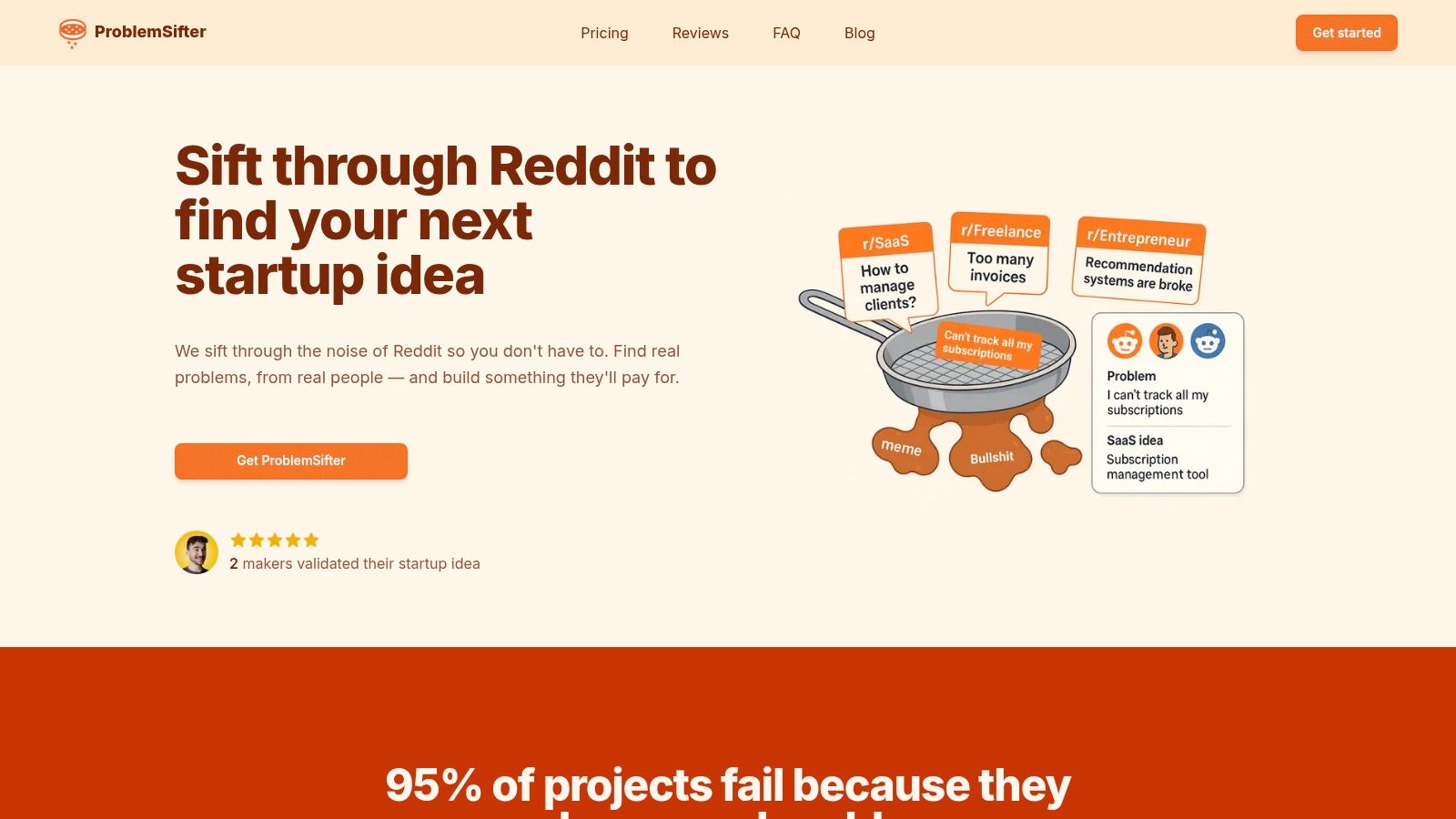
The platform is particularly powerful for early-stage entrepreneurs, SaaS founders, and indie hackers who need to move quickly and efficiently. Its unique output provides not just validated business ideas but also direct links to the Reddit discussions and the usernames of individuals who voiced the problems. This creates a ready-made list for initial customer discovery and targeted outreach, giving you a critical head start.
Key Features and Use Cases
- Problem-First Validation: The primary function is to deliver comprehensive reports of real user problems, saving countless hours of manual research. This data serves as the first and most critical component of a product launch plan.
- Targeted Outreach Engine: Unlike other ideation tools, ProblemSifter doesn't just suggest ideas—it connects you to the exact Reddit users asking for them. This is invaluable for both ideation and promoting your solution with targeted outreach.
- Actionable Reporting: Reports are delivered within 24 hours and include curated business ideas, potential SaaS opportunities, and direct links to high-engagement posts.
For just $49, you can get lifetime access to a curated list of real startup problems people are discussing in one subreddit ($99 for three). With no subscriptions and no hidden fees, it provides an unparalleled return. It’s a strategic first step that informs every subsequent stage of your launch, from feature prioritization to marketing messaging. While its insights are confined to Reddit, the depth and actionability of the data make it a standout choice for grounding your launch plan in reality.
Website: https://www.problemsifter.com
2. Figma – Product Launch Plan Template
Figma, primarily known as a collaborative UI design tool, offers a surprisingly robust product launch plan template through its whiteboarding tool, FigJam. This template is ideal for teams that thrive on visual, real-time collaboration. It allows product managers, marketers, and designers to simultaneously map out every launch phase, from pre-launch buzz to post-launch analysis, all within a single, shared canvas.
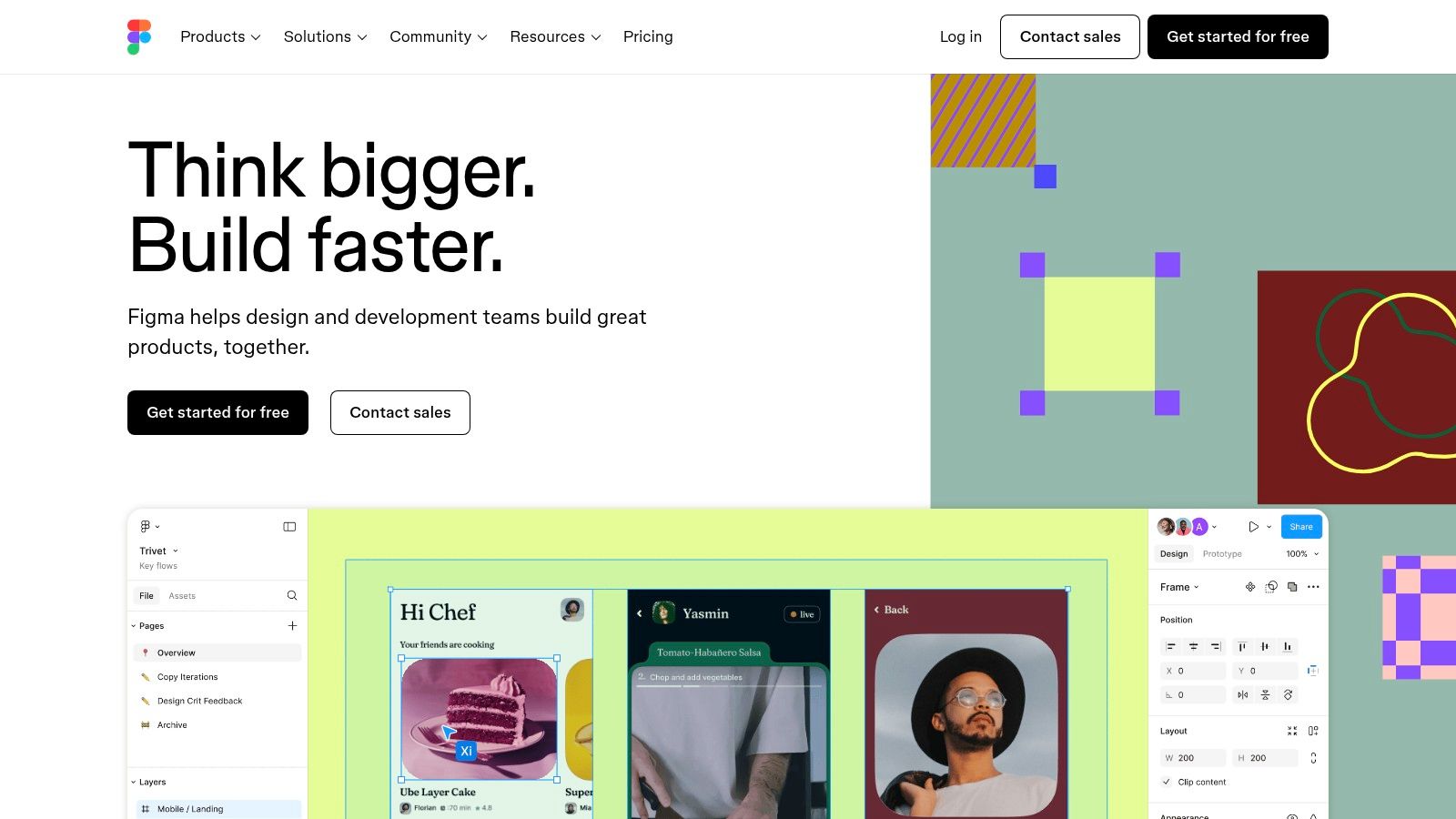
What makes Figma’s offering unique is its departure from traditional, rigid spreadsheet formats. Instead, it provides an infinitely flexible space where teams can use widgets, sticky notes, and connectors to create a dynamic plan that evolves with the project. This visual approach is especially effective for brainstorming launch risks or mapping out complex stakeholder communication flows. The user experience is exceptionally smooth, mirroring the high-quality interface Figma is known for.
Analysis and Recommendations
The core strength of this template is its collaborative nature. It excels in remote or hybrid team settings where instant feedback and shared ownership are critical. For instance, a marketing team can populate the content calendar section while the engineering team simultaneously updates the development timeline, providing immediate cross-functional visibility.
However, its reliance on a stable internet connection and limited offline capabilities can be a drawback for users who need to work on the go. While the template is free to use, accessing it requires a Figma account. The FigJam environment is intuitive, but teams accustomed to text-heavy documents might need a brief adjustment period to fully leverage its visual-first methodology.
| Feature | Analysis |
|---|---|
| Workspace | Fully collaborative, infinite canvas for visual planning. |
| Customization | Highly customizable with widgets, shapes, and drawing tools. |
| Access | Free to use with a Figma account, accessible via any web browser. |
| Limitations | Requires an active internet connection; not ideal for offline work. |
For more information, visit the Figma website.
3. Smartsheet – Free Product Launch Plan Templates
Smartsheet provides a comprehensive library of free product launch plan template options, catering to teams that prefer traditional, structured documentation. Unlike visual-first platforms, Smartsheet offers downloadable templates in familiar formats like Excel, Word, and PDF. These resources cover a wide spectrum of launch activities, including detailed marketing plans, go-to-market strategies, and communication roadmaps, making them suitable for various industries and launch complexities.
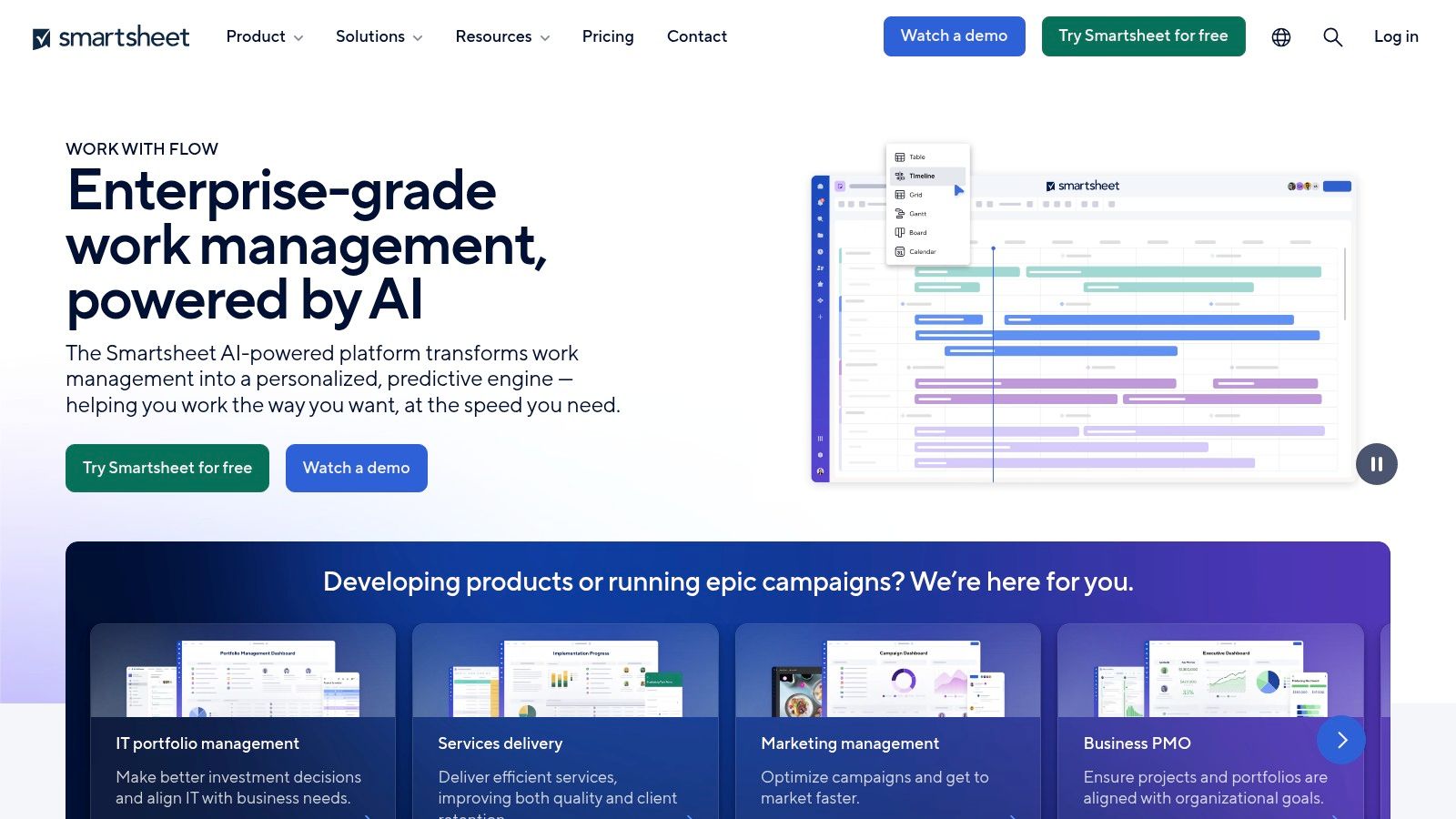
The key advantage of Smartsheet's collection is its depth and professional structure. The templates are pre-populated with essential fields, timelines, and checklists, providing a solid foundation for any product manager. This is particularly useful for teams that need to present formal plans to stakeholders or adhere to strict project management protocols. The documents are designed for easy customization, allowing users to adapt the frameworks to their specific product and market needs without starting from scratch.
Analysis and Recommendations
The strength of Smartsheet’s templates lies in their immediate utility and familiarity. A marketing manager can download an Excel template and begin populating it with campaign data instantly, without needing to learn a new interface. This is ideal for organizations that rely on Microsoft Office or Google Workspace for their daily operations and require well-defined, shareable documents.
However, a notable limitation is that while the static templates are free, unlocking their full collaborative and automated potential often requires a Smartsheet subscription. This can create a disjointed experience for teams hoping for real-time integration. New users may also find the sheer volume of information in some templates slightly overwhelming, necessitating an initial effort to tailor them down to essential components.
| Feature | Analysis |
|---|---|
| Workspace | Static document-based templates in Excel, Word, and PDF. |
| Customization | Fully customizable within their native applications (e.g., Excel). |
| Access | Free to download; full platform features require a paid subscription. |
| Limitations | Lacks real-time collaboration of cloud-native tools; can be complex. |
For more information, visit the Smartsheet website.
4. HubSpot – Product Launch Plan Template
HubSpot, a giant in the marketing and sales software space, offers a free and remarkably thorough product launch plan template. Available in Excel, PDF, and Google Sheets formats, this resource is designed for teams that prefer a structured, data-driven approach. It guides users through critical pre-launch stages, including defining product positioning, crafting key messaging, and performing detailed competitive analysis, all within a familiar spreadsheet environment.
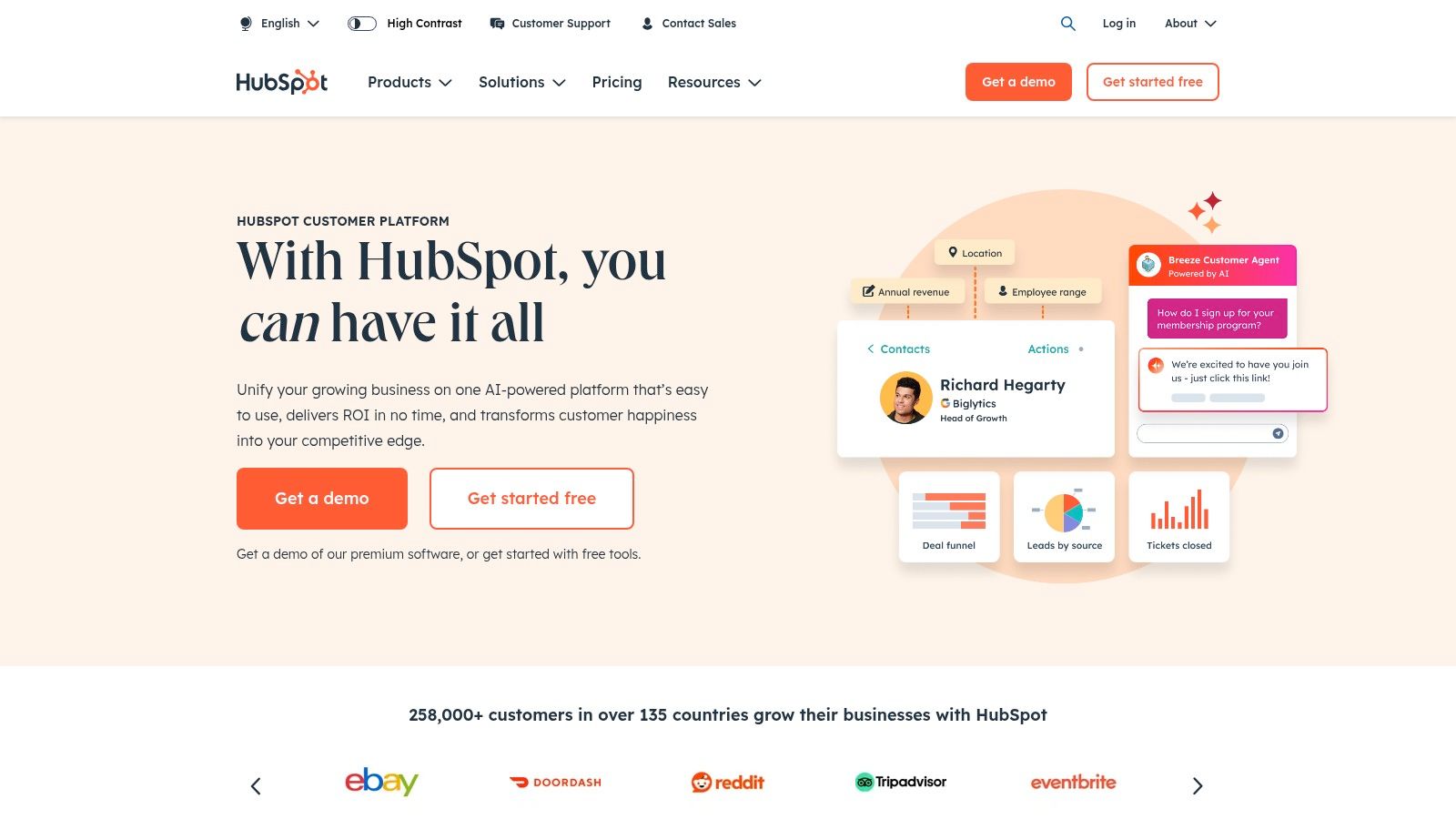
What sets HubSpot’s template apart is its emphasis on foundational marketing strategy. It isn’t just a checklist of tasks; it’s a framework that forces teams to answer the tough questions about market fit and value propositions before diving into execution. This makes it particularly valuable for startups and teams launching into competitive spaces, ensuring the core messaging is solid. The template’s clear sections help align stakeholders on the strategic direction from day one.
Analysis and Recommendations
The primary strength of this template is its comprehensive, marketing-first methodology, backed by HubSpot's extensive expertise. It’s ideal for product marketers who need to create a detailed, shareable document that covers every strategic angle. For example, the competitive analysis section provides a structured way to evaluate rivals, which is a crucial step often overlooked in more task-oriented templates. The insights gained from this process can be invaluable for finding a profitable market niche.
The main drawback is the access requirement. To download the template, you must provide your contact information, which inevitably leads to follow-up marketing communications from HubSpot. While the template itself is free, this data exchange is a key consideration. Its traditional format might also feel less dynamic for teams accustomed to agile, collaborative whiteboard tools like Miro or FigJam.
| Feature | Analysis |
|---|---|
| Workspace | Static document available in Excel, PDF, and Google Sheets formats. |
| Customization | Standard spreadsheet customization; users can add or remove rows and columns. |
| Access | Free to download, but requires submitting personal contact information. |
| Limitations | Lacks real-time collaboration features; may lead to marketing emails. |
For more information, visit the HubSpot website.
5. ProductPlan – Product Launch Plan Template
ProductPlan provides a specialized product launch plan template designed for product managers and marketers who need a clear, timeline-based view of their launch strategy. Unlike more flexible, open-canvas tools, ProductPlan focuses on structured roadmapping. This approach is perfect for coordinating complex, multi-departmental efforts where tracking dependencies and hitting deadlines are paramount. It allows teams to visualize the entire launch sequence, from development milestones to marketing campaigns, in a single, coherent timeline.
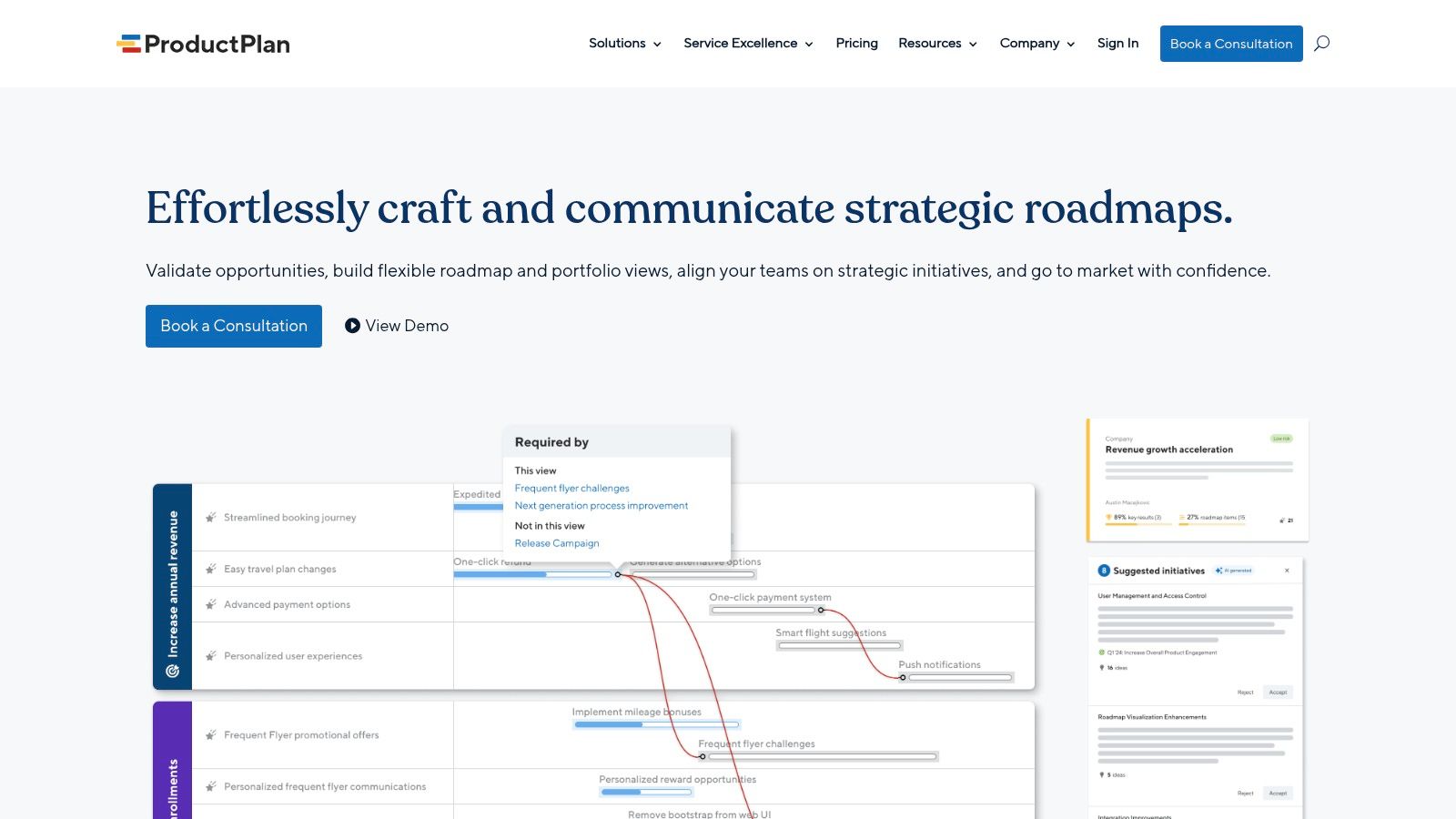
What sets ProductPlan apart is its use of swimlanes to delineate responsibilities across different teams like engineering, marketing, and sales. This feature brings exceptional clarity to cross-functional projects, ensuring every department understands its role and how it connects to the broader launch schedule. The platform excels at creating a high-level, shareable roadmap that communicates progress to stakeholders and keeps the entire organization aligned.
Analysis and Recommendations
The core strength of this template is its powerful visualization of complex timelines, making it ideal for established companies with formal product processes. For instance, a product marketing manager can use it to show executives exactly when the new website will go live, how it aligns with the PR push, and when the sales team will be fully enabled. This clarity helps prevent bottlenecks and ensures accountability.
However, its structured nature requires a ProductPlan subscription, making it a less accessible option for freelancers or very small startups. The interface, while powerful, can present a steeper learning curve for teams not accustomed to dedicated roadmapping software. It is less suited for initial, free-form brainstorming compared to a tool like FigJam.
| Feature | Analysis |
|---|---|
| Workspace | Timeline-based roadmap with swimlanes and milestones. |
| Customization | Good customization within the roadmap structure; less free-form. |
| Access | Requires a paid ProductPlan subscription for full access and use. |
| Limitations | May be overly complex for small teams; not a free resource. |
For more information, visit the ProductPlan website.
6. Demand Metric – Product Launch Plan Template
For teams that require a highly structured, document-driven approach, Demand Metric offers a comprehensive product launch plan template in Microsoft Word format. This resource is engineered for accountability, guiding teams through every phase of the launch process. It is particularly effective for securing executive buy-in and formalizing the project scope, making it an excellent tool for corporate environments where detailed documentation is paramount.
The template’s strength lies in its meticulous, 11-section layout that covers everything from the executive summary and risk assessment to a detailed go-to-market strategy. This formal structure ensures no critical element is overlooked, making it a reliable blueprint for complex launches. By providing clear sections for goals, budgets, and team responsibilities, it systemizes the entire planning process, transforming abstract objectives into an actionable document.
Analysis and Recommendations
The primary advantage of the Demand Metric template is its focus on formal documentation and accountability. It is an ideal resource when a launch plan must serve as an official record or be presented for budget approval. The detailed sections prompt teams to think through every contingency and stakeholder requirement, which can prevent costly oversights later in the project lifecycle.
However, its depth can also be a drawback. For smaller teams or simpler product launches, the level of detail may feel excessive and slow down the process. Accessing this robust template requires a Demand Metric membership, which presents a barrier for those seeking a free, quick-start solution. Teams working in fast-paced, agile environments might find a more flexible, visual tool like FigJam or Miro to be a better fit for their iterative workflow.
| Feature | Analysis |
|---|---|
| Workspace | Microsoft Word document with 11 pre-defined sections. |
| Customization | Standard Word document editing; content is customizable but the structure is rigid. |
| Access | Requires a paid Demand Metric membership to download and use. |
| Limitations | May be overly detailed for small projects; static format lacks real-time collaboration. |
For more information, visit the Demand Metric website.
7. PreWrite – Product Launch Marketing Plan Template
PreWrite offers a specialized product launch marketing plan template for teams that prefer the familiarity of traditional document editors. Available for a one-time purchase, this template comes in MS Word, Apple Pages, and PDF formats, making it highly accessible and easy to integrate into existing workflows. It’s designed specifically for marketing teams to detail core launch activities, focusing heavily on pricing strategy, promotional calendars, and defining the debut date.
What sets PreWrite apart is its direct, no-frills approach. Instead of a collaborative platform, it provides a straightforward, editable document that serves as a foundational marketing blueprint. This is ideal for smaller teams or solo entrepreneurs who need a structured yet flexible guide without the complexity of a project management tool. The template’s focus on marketing fundamentals ensures all critical promotional aspects are covered comprehensively before launch.
Analysis and Recommendations
The primary strength of this template is its focused, actionable content. It guides users through creating a detailed marketing strategy, which is invaluable for ensuring your product reaches the right audience. For instance, you could use the pricing section to model different tiers and then validate those assumptions by conducting customer interviews to understand user pain points, a crucial step for any launch. You can learn more about conducting effective customer discovery interviews to better inform your strategy.
The main limitation is its scope; it is purely a marketing plan. Teams will need to supplement it with other tools for project management, product development tracking, and cross-functional collaboration. The one-time cost, while affordable, means it isn’t free. It’s best suited for marketing managers who need a dedicated, document-based plan to present to stakeholders or to guide their team’s execution.
| Feature | Analysis |
|---|---|
| Workspace | Static document formats (MS Word, Apple Pages, PDF). |
| Customization | Fully editable text and layout within standard document editors. |
| Access | Requires a one-time purchase of $10.98 per template. |
| Limitations | Lacks collaboration features; focused solely on marketing tasks. |
For more information, visit the PreWrite website.
8. EdrawMind – Product Launch Plan Template
EdrawMind offers a distinct, mind-map-based product launch plan template for teams that benefit from a highly visual and hierarchical planning structure. This tool helps product managers and marketing teams lay out launch objectives, communication strategies, and staff responsibilities in a clear, branching format. It's designed to transform complex launch sequences into an easily digestible diagram, promoting alignment across departments.
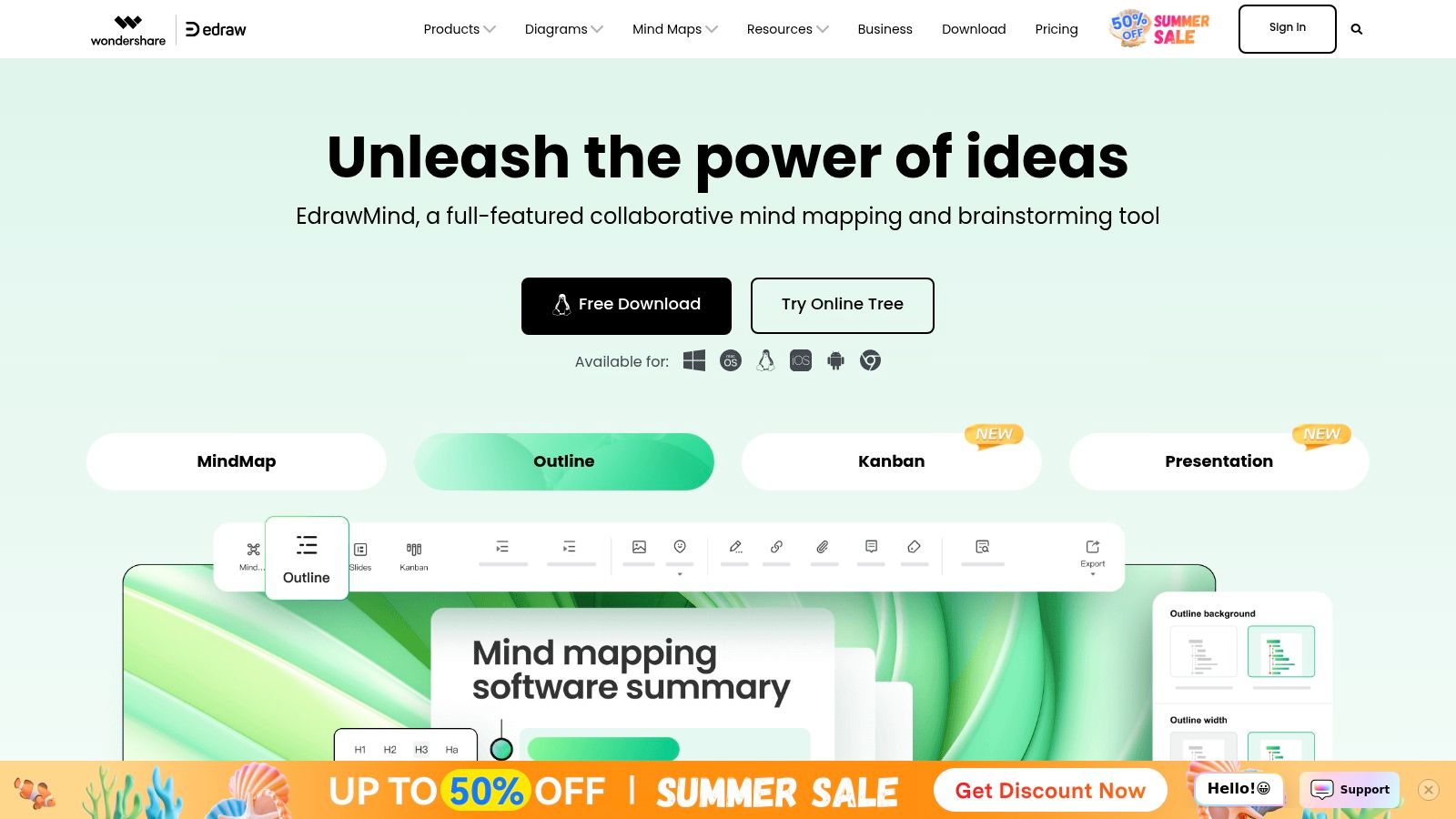
What sets EdrawMind apart is its focus on mind mapping as the core planning mechanism. Instead of rows and columns, users build out their launch plan from a central idea, adding branches for key activities like market research, content creation, and sales enablement. This visual approach is particularly effective for brainstorming and organizing ideas organically. The user interface is clean, with drag-and-drop functionality that makes structuring the plan straightforward, even for those new to mind mapping software.
Analysis and Recommendations
The key strength of EdrawMind’s template is its ability to visually simplify complex information, making it easier for all stakeholders to grasp the entire launch strategy at a glance. It's especially useful during the initial planning and brainstorming phases. For example, a team can use the mind map to effectively define and segment its core demographic, a crucial step you can learn more about by understanding how to find your target audience.
However, the tool's specialized format can be a limitation. It requires users to download the EdrawMind software, and teams unfamiliar with mind mapping might face a slight learning curve. While excellent for high-level strategy, it may be less suited for tracking granular, day-to-day tasks compared to a traditional project management tool.
| Feature | Analysis |
|---|---|
| Workspace | Mind map-based canvas for hierarchical visual planning. |
| Customization | Good customization with various themes, layouts, and clip art. |
| Access | Requires downloading EdrawMind software; available for multiple platforms. |
| Limitations | The mind map format can be restrictive for detailed task tracking. |
For more information, visit the EdrawMind website.
9. Teamwork – Product Launch Plan Template
Teamwork embeds its product launch plan template directly into its comprehensive project management suite, creating a single source of truth for launch activities. This template is designed for teams that need to centralize communication, track progress against milestones, and manage complex dependencies. It transforms the launch plan from a static document into a dynamic, interactive workspace where every task and discussion is connected.

What sets Teamwork apart is its focus on integrating planning with execution. The template isn't just a checklist; it's the foundation for assigning tasks, setting deadlines, logging hours, and managing workloads. This is especially useful for ensuring accountability and providing clear visibility into project status for all stakeholders, from marketing to development. The interface is clean and structured, making it easy to navigate complex project timelines.
Analysis and Recommendations
The core benefit of Teamwork's template is its power to enhance cross-functional collaboration and maintain project momentum. For example, a project manager can instantly see if a delay in completing a marketing asset will impact the scheduled engineering deployment, allowing for proactive adjustments. This level of integrated oversight is crucial for meeting tight launch deadlines and maintaining alignment across departments.
However, its strength is also a potential drawback. The template requires a paid Teamwork subscription, and its feature-rich environment might be overly complex for smaller teams or straightforward launches. Teams that are not already using or willing to adopt the Teamwork ecosystem will find it less accessible than a standalone template.
| Feature | Analysis |
|---|---|
| Workspace | Integrated project management suite with task lists, Gantt charts, and boards. |
| Customization | Templates are fully customizable to add or remove phases, tasks, and dependencies. |
| Access | Requires a paid Teamwork subscription; not available as a standalone free template. |
| Limitations | Can have a steep learning curve for new users; may be too robust for simple projects. |
For more information, visit the Teamwork website.
10. Free Todo List – Comprehensive Product Launch Plan
Free Todo List offers a refreshingly simple and effective product launch plan template for teams that prioritize clarity over complexity. It presents a 26-item checklist that covers the essential stages of a product launch, from initial planning and market research to post-launch monitoring. This no-frills approach is perfect for startups, solopreneurs, or small teams needing a straightforward way to track progress without the overhead of more sophisticated project management software.
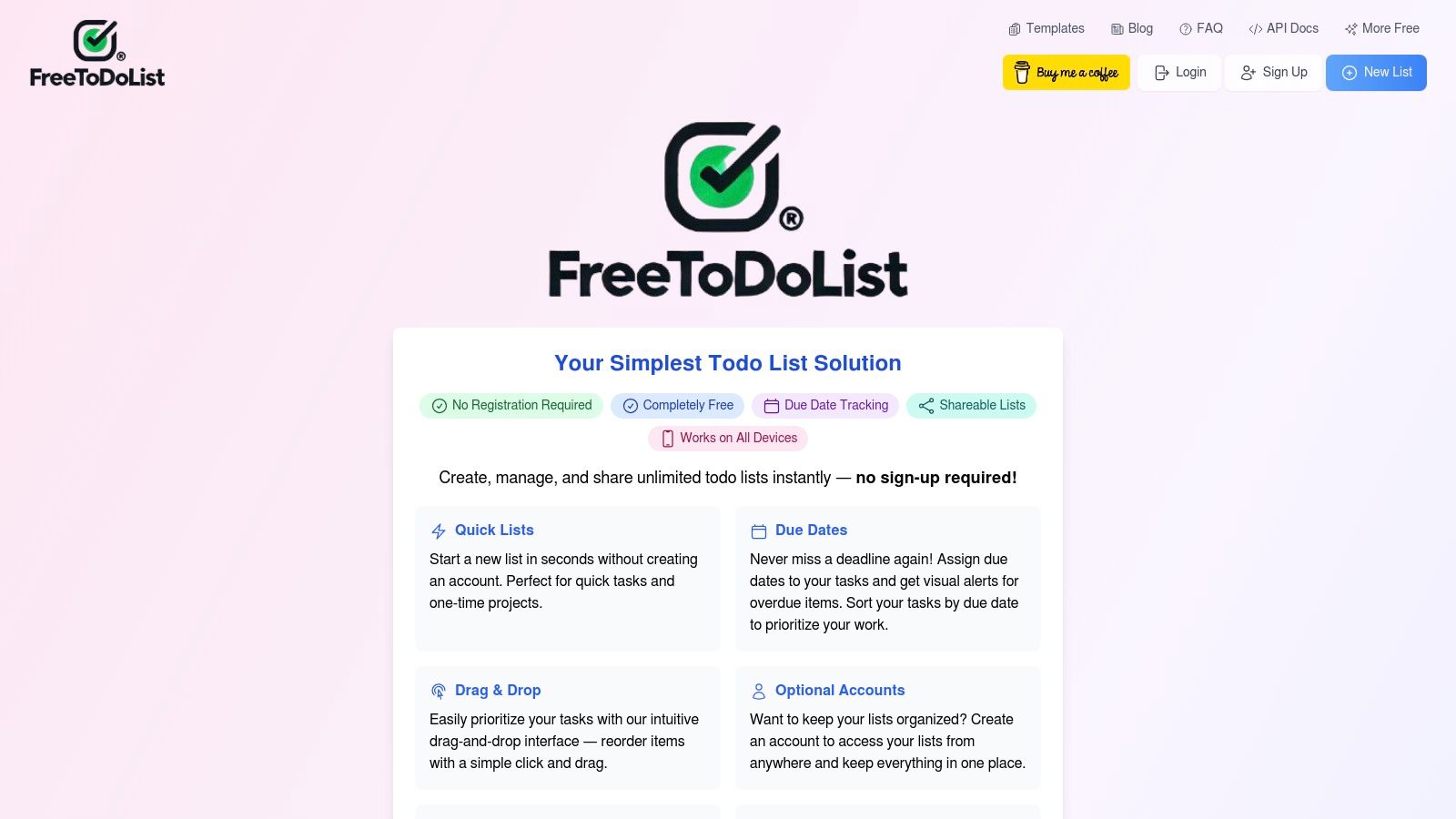
What makes this template stand out is its pure focus on action items. It strips away complex features, providing a clean interface with tasks and due dates. Users can easily customize the list, adding or removing items to fit their specific project scope. This minimalist design ensures that the team stays focused on execution, making it an excellent tool for ensuring fundamental launch activities are not overlooked amidst the chaos of bringing a new product to market.
Analysis and Recommendations
The primary strength of this template lies in its simplicity and accessibility. It is completely free and requires no account signup, allowing teams to get started in seconds. For instance, an indie hacker can quickly copy the checklist to manage their launch tasks without investing time or money in a new tool. This makes it an ideal supplementary resource to be used alongside more strategic tools. For example, after identifying key customer pain points on a platform like ProblemSifter, you can directly translate those insights into actionable marketing and development tasks within this checklist.
However, its simplicity is also its main limitation. The template lacks advanced features like collaboration, integrations, or detailed sub-task management, which are critical for larger or more complex projects. Teams requiring cross-functional visibility and real-time updates may find it insufficient for their needs.
| Feature | Analysis |
|---|---|
| Workspace | Simple, single-user checklist format. |
| Customization | Basic customization of task names and due dates. |
| Access | Completely free, no account required, accessible via web browser. |
| Limitations | Lacks collaboration features; not suitable for complex, multi-layered projects. |
For more information, visit the Free Todo List website.
11. PandaDoc – Product Launch Marketing Plan Template
PandaDoc, a platform known for its document workflow and e-signature capabilities, offers a free and highly structured product launch marketing plan template. This resource is tailored for teams that need a formal, comprehensive document to guide their launch. It serves as a detailed roadmap, covering essential sections from market analysis and target audience definition to messaging, timelines, and budget allocation.
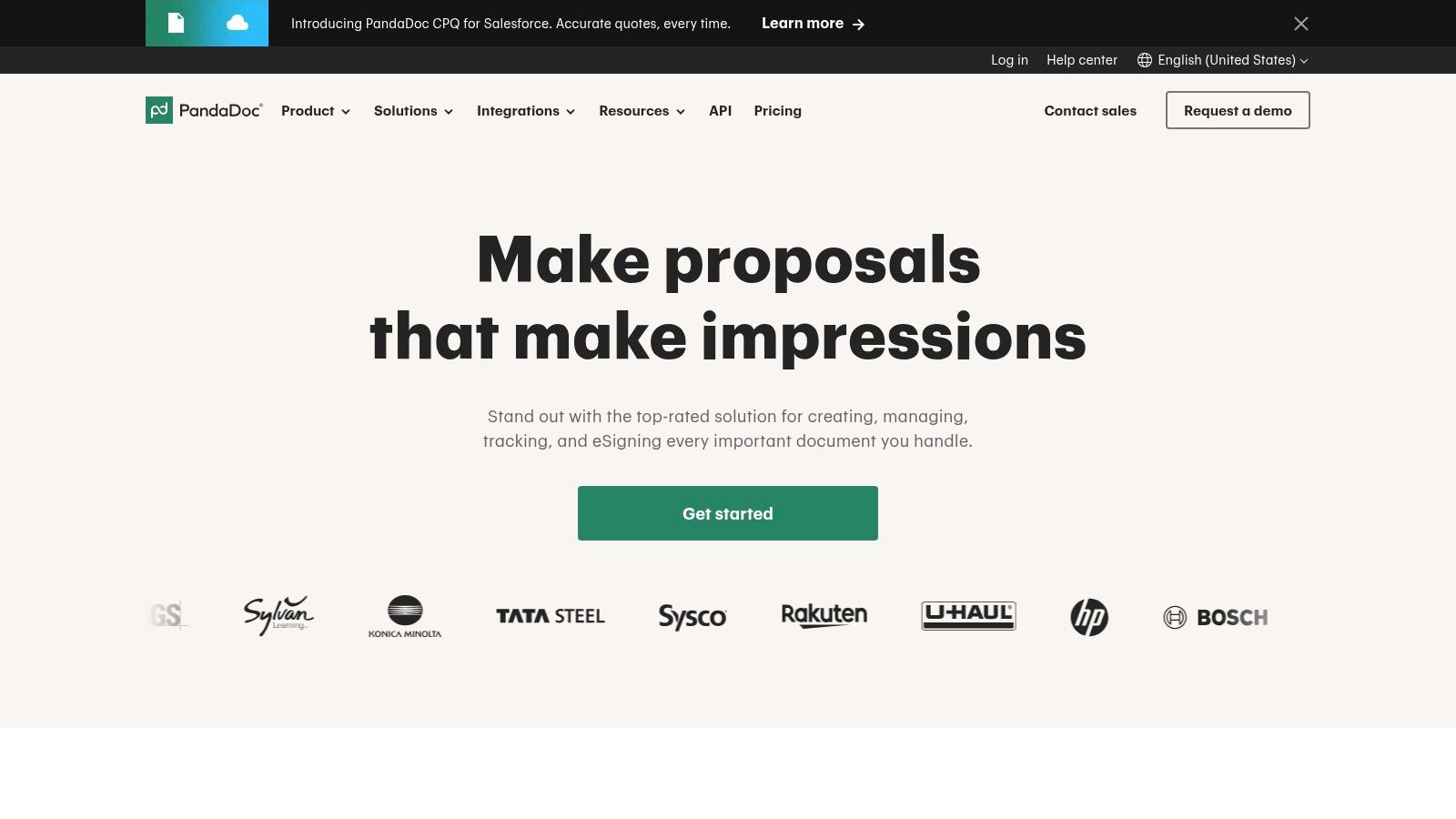
What sets the PandaDoc template apart is its integration with document management and e-signature functionalities. This transforms a static plan into an actionable, official document that can be shared with stakeholders for sign-off. The template is fully editable, allowing teams to customize every section to fit their specific product and industry needs, making it a powerful tool for ensuring formal alignment across departments before execution begins.
Analysis and Recommendations
The key strength of this template is its professional, document-centric approach. It's perfect for launches requiring formal approval from leadership or external partners. For example, a project manager can complete the plan, send it to the CMO for review, and receive an electronic signature directly within the platform, creating a clear audit trail. This level of formality is often missing from more collaborative, visual-first tools.
However, using the template requires creating a free PandaDoc account, which may lead to follow-up marketing communications from the company. While the template itself is comprehensive, its environment is less suited for real-time brainstorming compared to whiteboard-style platforms. It excels at formalizing a plan rather than ideating one from scratch.
| Feature | Analysis |
|---|---|
| Workspace | Document-based editor focused on structured content. |
| Customization | Fully editable sections to align with specific launch needs. |
| Access | Free to use but requires signing up for a PandaDoc account. |
| Limitations | Less suited for dynamic, real-time collaboration; signup required. |
For more information, visit the PandaDoc website.
12. Asana – Free Product Launch Template
Asana, a dominant force in project management, offers a highly functional and free product launch plan template directly within its platform. This template is built for teams that need to coordinate complex, multi-layered tasks across different departments. It excels at turning a high-level launch strategy into a granular, actionable plan where every team member, from marketing to engineering, has clear ownership and visibility over their responsibilities.
What sets Asana’s template apart is its deep integration with its core task management features. You can switch between List, Board, Timeline, and Calendar views to visualize progress in the way that best suits your workflow. The ability to create dependencies, set milestones, and automate routine tasks makes it incredibly powerful for preventing bottlenecks and ensuring deadlines are met. This structure provides a level of operational control that more visual or document-based templates cannot match.
Analysis and Recommendations
The key strength of this template is its structured approach to cross-functional collaboration. It provides a single source of truth that keeps everyone aligned on goals, timelines, and individual deliverables. For example, a product manager can track the entire launch from a high-level timeline, while a content marketer can focus on their specific tasks in the board view, with all progress updated in real-time for stakeholders to see.
While the template is free, it exists within the Asana ecosystem, which requires an account. New users may face a slight learning curve as they get accustomed to Asana's interface and feature set. However, for teams already using or willing to adopt Asana, this template is an invaluable tool for executing a disciplined and organized product launch.
| Feature | Analysis |
|---|---|
| Workspace | Integrated task management with multiple views (List, Board, Timeline). |
| Customization | Highly customizable fields, sections, and task automation rules. |
| Access | Free to use with a standard Asana account. |
| Limitations | Requires user onboarding for those new to the Asana platform. |
For more information, visit the Asana website.
Product Launch Plan Template Comparison
| Product | Core Features | User Experience & Quality | Value Proposition | Target Audience | Price |
|---|---|---|---|---|---|
| ProblemSifter | Mines targeted subreddits for real pain points | Fast 24-hr report delivery, revisions | Saves hours of research, validated ideas | Founders, indie hackers, makers | $49 (1 subreddit), $99 (3) - lifetime |
| Figma – Product Launch Plan | Editable timelines, collaboration widgets | User-friendly, encourages teamwork | Free, easy planning | Teams needing collaborative plans | Free |
| Smartsheet – Launch Templates | Excel/Word/PDF templates, customizable | Detailed, structured templates | Free downloads, versatile | Multi-industry teams | Free |
| HubSpot – Launch Plan | Multi-format, positioning & competitive analysis | Comprehensive, easy to use | Free with marketing expertise | Marketers, product teams | Free (contact required) |
| ProductPlan – Roadmap Template | Timeline roadmap, swimlanes, milestones | Visual, collaborative | Tracks deadlines, alignment | Product marketing teams | Subscription required |
| Demand Metric – Launch Template | 11 detailed sections, budget & risk assessment | Structured, accountability focused | Facilitates budget approval | Teams needing detailed plans | Membership required |
| PreWrite – Marketing Plan | Multi-format, pricing & promotion focused | Customizable | Affordable ($10.98), marketing focused | Marketers needing focused plan | Paid ($10.98) |
| EdrawMind – Mind Map Template | Visual mind map, collaboration support | Intuitive visuals | Enhances team alignment | Collaborative teams | Requires software |
| Teamwork – Launch Template | Centralized communication, progress tracking | Enhances collaboration | Improves deadline management | Project teams | Subscription required |
| Free Todo List – Task Template | 26-item task list with due dates | Simple, straightforward | Free, easy progress tracking | Small teams, simple projects | Free |
| PandaDoc – Marketing Template | Editable sections, e-signature support | Detailed, structured | Free, supports signatures | Marketing/project teams | Free (account needed) |
| Asana – Product Launch Template | Integrated task mgmt, recommended apps | Collaborative, real-time updates | Free, workflow integration | Teams using Asana | Free (account needed) |
Building Your Launch Engine: From Template to Triumph
Navigating the landscape of product launch plan templates can feel overwhelming, but as we've explored, the goal isn't to find a single "perfect" document. Instead, the objective is to select a foundational framework that aligns with your team's unique operational style, technical stack, and strategic goals. The true power of a template lies not in its static structure, but in its adaptability. It must evolve from a checklist into a dynamic, living blueprint for your entire launch campaign.
We've analyzed a diverse array of options, from the visually collaborative nature of Figma and EdrawMind to the structured, data-driven environments of Smartsheet and Asana. We've seen how comprehensive platforms like HubSpot and Teamwork integrate launch planning directly into broader marketing and project management ecosystems. Each tool offers a distinct approach, catering to different needs, whether you're a solopreneur coordinating a lean launch or a product manager orchestrating a complex, multi-departmental release.
Synthesizing Your Strategy: From Idea to Execution
The most critical takeaway is that a successful launch begins long before you select a template. The ultimate success of any product is determined by its resonance with a genuine customer need. A meticulously executed launch plan for a product nobody wants is a wasted effort. This is where the strategic importance of pre-template groundwork becomes paramount.
Before you even consider Gantt charts or task assignments, your focus must be on problem validation. Tools like ProblemSifter are instrumental in this foundational stage, shifting your perspective from "what can I build?" to "what problem can I solve?" By identifying unfiltered pain points directly from communities like Reddit, you're not just sourcing an idea; you're discovering your future customers and their exact language. This insight is the fuel for your entire launch engine, informing everything from your value proposition and marketing copy to your feature prioritization.
Actionable Next Steps: Choosing and Implementing Your Template
With a validated problem in hand, your path forward becomes clearer. Use the following considerations to transition from analysis to action:
- Assess Your Team's Workflow: Do you thrive in visual, drag-and-drop interfaces (Figma, EdrawMind), or do you require the rigorous, spreadsheet-like organization of a tool like Smartsheet or the integrated task management of Asana? Choose a format that minimizes friction and encourages adoption.
- Evaluate Integration Needs: Consider how your chosen product launch plan template will connect with your existing tools. Does it need to sync with your CRM (HubSpot), your document repository (PandaDoc), or your project management suite (Teamwork)? A well-integrated template prevents information silos.
- Customize, Don't Just Copy: Treat any template as a starting point. Ruthlessly delete irrelevant sections and add custom tasks specific to your product and market. The goal is to create a tailored plan that reflects your unique strategy, not a generic checklist.
Ultimately, the best product launch plan template is the one you actually use. It should serve as your team's single source of truth, a strategic guide that keeps every stakeholder aligned and every task on track. By grounding your plan in a validated user problem and selecting a tool that fits your team's natural rhythm, you transform a simple document into a powerful catalyst for a triumphant launch.
Before you build your launch plan, make sure you're building the right product. Stop guessing and start solving real problems with ProblemSifter. Our platform gives you lifetime access to a curated feed of validated business ideas, complete with the Reddit posts and users who are asking for a solution, so you can build with confidence.
